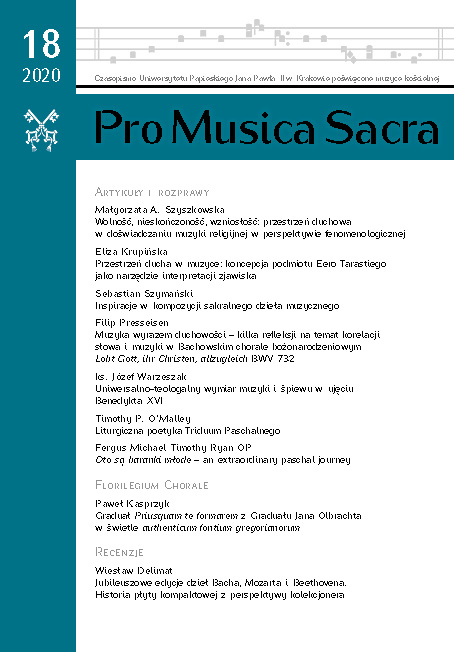The space of spirituality in music: the concept of a subject by Eero Tarasti as an instrument for interpreting a phenomenon
DOI:
https://doi.org/10.15633/pms.3707Keywords:
semiotics, Tarasti, Greimas, sacred music, musical subject, sign, meaning, interpretation, theology, aestheticsAbstract
The spiritual dimension of music has always been shrouded in a mystery. In 19th c. some desperate attempts were made to capture the spirituality of music by resorting, on the one hand, to the sphere of metaphors and essayism, on the other, to philosophical tools. The aesthetics of emotions, however, began at some point to be uncomfortable. “The inexpressible” of music, be at first its highest virtue, led no farther than to the sphere of poetics without explaining the phenomenon of musical transcendence. The 60’and the 70’of 20th c. brought the instruments of the structural musical semiotics. The latter, despite its neo-positivist and laboratory precision, shunned the significance of extra-musical subject matters, confining its research to some neutral levels and believing in the existence of an objective text of a music work. “The semantic turn” brought a new branch of semiotics exposing the very process of meaning understood as a dynamic act inextricably linked with a cultural context. In this semiotic perspective it is suggested to interpret the phenomenon of spiritual content of music by employing the elements of the concept of a subject defined by Eero Tarasti. The existential Me and the social Self explain many ideas related to extra-musical subject matters of a music piece (particularly those of theological and metaphysical nature) helping to understand the mechanism of merging “cultural subject matters” into semantic relationships.References
Arendt H., Heidegger M., Korespondencja z lat 1925–1975, przekł. S. Lisiecka, Warszawa 2010.
Balthasar H. U. von, Rozwój idei muzycznej, w: H. U. von Balthasar, Pisma wybrane, t. 2, przekł. M. Urban CSsR, Kraków 2007.
Buczyńska-Garewicz H., Semiotyka Peirce’a, Warszawa 1994.
Davies J. B., The psychology of music, London 1978.
Fontanille J., Soma et séma: Figures du corps, Paris 2005.
Fubini E., Historia estetyki muzycznej, Kraków 2002.
Gombrich E. H., Pisma o sztuce i kulturze, Kraków 2011.
Kravchenko V., The symbolic structure of Alexander Scriabin’s „Mystery”, w: Music and the Arts: Proceedings from ICMS 7, vol. 2, ed. E. Tarasti, Helsinki 2006, s. 712–722 (Acta Semiotica Fennica, 23. Approaches to Musical Semiotics, 10).
Lechte J., Panorama współczesnej myśli humanistycznej. Od strukturalizmu do postmodernizmu, przekł. T. Baszniak, Warszawa 1999.
Molino J., Fait musical et sémiologie de la musique, „Musique en jeu” 1975 num. 17, s. 37–62.
Nattiez J.-J., Fondements d’une sémiologie de la musique, Paris 1975.
Pelc J., Wstęp do semiotyki, Warszawa 1984.
Rosner K., A. J. Greimasa semiotyka narracji, „Pamiętnik Literacki” 67 (1976) nr 2, s. 341–352.
Smith T. A., More Evidence of Numeral–Logical Design in Bach’s „St. Matthew Passion”, „Bach” 17 (April, 1986) no. 2, s. 24–30.
Spitzer M., The Sense of Music: Semiotic Essays by Raymond Monelle, „Music & Letters” 83 (Aug., 2002) no. 3, s. 506–509.
Tarasti E., Introduction to a philosophy of music, w: Music and the Arts: Proceedings from ICMS 7, ed. by E. Tarasti, Helsinki 2006 (Acta Semiotica Fennica, 23. Approaches to Musical Semiotics, 10).
Downloads
Published
Issue
Section
License
Copyright (c) 2020 Eliza Krupińska

This work is licensed under a Creative Commons Attribution 4.0 International License.
Authors who publish with this journal agree to the following terms:
- Authors retain the copyright and full publishing rights without restrictions, and grant the journal right of first publication with the work simultaneously licensed under a Creative Commons Attribution 4.0 International License that allows others to share the work with an acknowledgement of the work's authorship and initial publication in this journal.
- Authors are able to enter into separate, additional contractual arrangements for the non-exclusive distribution of the journal's published version of the work (e.g., post it to an institutional repository or publish it in a book), with an acknowledgement of its initial publication in this journal.
- Authors are permitted and encouraged to post their work online (e.g., in institutional repositories or on their website) prior to and during the submission process, as it can lead to productive exchanges, as well as earlier and greater citation of published work (See The Effect of Open Access).

